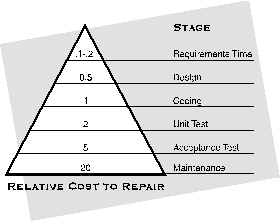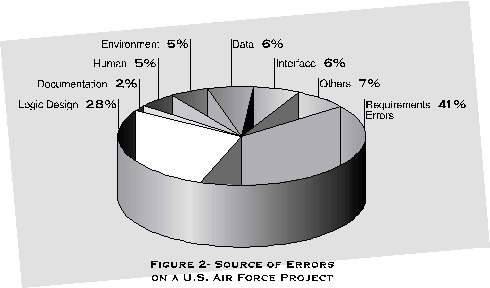

|
Calculating your return on investment from effective requirements management
Dean Leffingwell
Software developers can improve project outcomes and deliver high-quality software on time, on budget, by working to reduce requirements errors. This white paper presents compelling reasons to invest in a more communicative and managed requirements assessment process.
|
| Project Impairment Factors | % of Responses |
| 1) Lack of User Input | 12.8% |
| 2) Incomplete Requirements and Specifications | 12.3% |
| 3) Changing Requirements and Specifications | 11.8% |
Table 1: Standish Group Project Impairment Factors
It seems that our inability to work more effectively with users to better understand their requirements, coupled with weak engineering discipline in managing requirements, is the leading cause of software failures.
Studies performed at GTE, TRW, and IBM measured and assigned costs to errors occurring at various phases of the project life-cycle 3 . These statistics were confirmed in later studies 4 . Although these studies were run independently, they all reached roughly the same conclusion: If a unit cost of one is assigned to the effort required to detect and repair an error during the coding stage, then the cost to detect and repair an error during the requirements stage is between five to ten times less. Furthermore, the cost to detect and repair an error during the maintenance stage is twenty times more. Figure 1 below illustrates a summary of the results.

The reasons for this large difference is that many of these errors are not detected until well after they have been made. This delay in error discovery means that the cost to repair includes the cost to correct the offending error and to correct subsequent investments in the error. These investments include redesign of code, documentation rewrite, and the cost to rework or replace software in the field.
These studies illustrate that errors made in the requirements phase are extremely expensive to repair. If such errors occurred infrequently, then the contribution to overall cost would not be significant. However, requirements errors are indeed the largest class of errors typically found in a complex software project. In a study of a US Air Force project by Sheldon 5 , errors were classified by source. It was found that requirements errors comprised 41% of the errors discovered, while logic design errors made up only 28% of the total error count. Other studies back this result. For example, Tavolato and Vincena, quoting Tom DeMarco, report that 56% of all bugs can be traced to errors made during the requirements stage 6 .

In a study performed at Raytheon, Dion reported that approximately 40% of the total project budget was spent in rework costs 7 . Boehm reports that the cost of rework can approach 50% for the largest software projects. Because of their large number, and the multiplying effect, finding and fixing requirements errors consumes between 70% - 85% of total project rework costs.
There is no silver bullet with which to make your requirements errors go away. However, organizations have demonstrated that the following techniques are effective in reducing these types of errors:
In order to become proficient in these activities, an investment in both tools and training for key project personnel will be required.
Consider an application which contains 50,000 lines of code and is produced by a staff of six developers supported by one program manager, two software testers and one quality assurance person. To determine the product time line, let's assume coding is the critical path (probably a defensible assumption in most organizations!). Based upon a productivity rate of 350 lines of debugged source code per month 8 , then the project timeline is 24 months. (i.e. 50,000 LOC face=Symbol>/350 LOC/month face=Symbol> 6 developers). If the loaded cost per developer/tester/QA personnel per month is $10,000, then that creates a total project budget of approximately $2.4 Million. Of this cost, even if only 30% of the project is invested in rework (an optimistic assumption?), then the total rework budget is $720,000. If 70% of the rework is due to requirements errors, then the total rework costs related to requirements errors are over half a million dollars!
| Typical Project | Your Project | ||
| Number of lines of code | 50,000 | ||
| Number of developers | 6 | ||
| Person months of coding | 142.9 | ||
| Time to market | 24 calendar months | ||
| Loaded cost/team member/mo | $10,000 | ||
| Total project labor cost | $2,400,000 | ||
| Total rework costs (30%) | $720,000 | ||
| Total requirements errors rework cost (>>70%) | $504,000 |
Table 2: Project Cost Estimates for a Software Project
What's to be done to rework this valueless project activity? Simple, REDUCE REQUIREMENTS ERRORS. The techniques demonstrated above could be expected to have a dramatic effect on reducing requirements errors. However, as with any meaningful process, an investment in both tools and training is required for success. Let's assume that an organization purchases Requisite's RequisitePro toolkit and training in both requirements management principles and tool usage for the project staff. This would require an investment of approximately $19,900 [ten people *($995 tool+$995 training)]. How would this investment pay off?
No one can predict exactly how effective your organization will be in reducing requirements errors. However, it seems reasonable to assume that a 20% or more reduction in requirements errors can be accomplished at various levels of organizational maturity. Because of the multiplying effect, any such reduction can have a dramatic overall effect to your project's bottom line as Table 3 below shows.
| Case 1 | Case 2 | Case 3 | Your Project | |
| Requirements error reduction percentage | 10% | 20% | 40% | |
| Cost savings on typical project | $50,400 | $100,800 | $201,600 | |
| >Months shaved off time-to-market | 1.0 | 1.7 | 2.5 | |
| Payback time for investment in months | 9.5 | 4.7 | 2.4 | |
| % Return on investment over life of First project | 153% | 407% | 913%& |
Table 3: Return on Investment of More Effective Requirements Management
Table 3 above shows that the investment in requirements management tools and training can provide a truly extraordinary payback even on the first project. Thereafter, the team's ability to reduce requirements errors will continue to pay a substantial dividend on future projects.
But these hard costs exclude the intangible costs associated with a requirements error. Intangible costs include lack of features that could have been delivered had the project's resources not been devoted to rework, loss of confidence on the part of customers, and accompanying lost and unrecoverable market share, revenue and profit.
Taken together, these costs clearly demonstrate that a company cannot afford to ignore the benefits of better requirements management!
1. Alsop. S, "The Trouble with Software Is ... It Sucks", Fortune Magazine, June 10, 1996
2. The Standish Group, Chaos Report, 1994
3. Davis, A., "Software Requirements - Objects, Functions and States", Prentice Hall, 1993
4. Boehm, B. and Papaccio, C. "Understanding and Controlling Software Costs", IEEE Transactions of Software Engineering, Oct 1988
5. Sheldon, F. et al, "Reliability Measurement from Theory to Practice", IEEE Software, July 1992
6. Tavolato, P., and K. Vincena. "A Prototyping Methodology and Its Tool." In Approaches to Prototyping, R Budde et al., eds., Berlin: Springer-Verlag, 1984.
7. Dion, R. "Process Improvement and the Corporate Balance Sheet," IEEE Software, (July 1993), pp. 28-35
8. Grady, R. "Practical Software Metrics for Project Management and Process Improvement", Prentice-Hall, Inc. 1992
 Dean Leffingwell was Senior Vice President of Process and Project Management at Rational, and was responsible for methodology, the Rational Unified Process, customer education and training, and the company's products in the requirements, change request management, and project management disciplines. The lead author of Managing Software Requirements, A Unified Approach (Addison Wesley Longman, 1999), he holds an M.S. in engineering from the University of Colorado.
Dean Leffingwell was Senior Vice President of Process and Project Management at Rational, and was responsible for methodology, the Rational Unified Process, customer education and training, and the company's products in the requirements, change request management, and project management disciplines. The lead author of Managing Software Requirements, A Unified Approach (Addison Wesley Longman, 1999), he holds an M.S. in engineering from the University of Colorado.
You can read more information here.